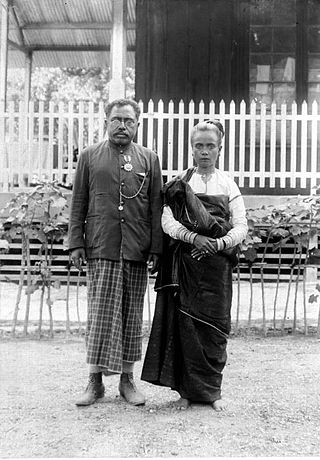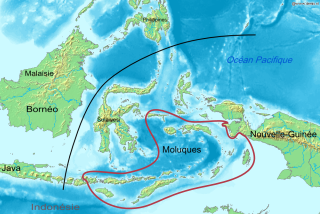
Flores is one of the Lesser Sunda Islands, a group of islands in the eastern half of Indonesia. Administratively, it forms the largest island in the East Nusa Tenggara Province. Including Komodo and Rinca islands off its west coast, the land area is 14,731.67 km2, and the population was 1,878,875 in the 2020 Census ; the official estimate as of mid-2023 was 1,962,405. The largest towns are Maumere and Ende. The name Flores is of Portuguese origin, meaning "Flowers".

Sumbawa is an Indonesian island, located in the middle of the Lesser Sunda Islands chain, with Lombok to the west, Flores to the east, and Sumba further to the southeast. Along with Lombok, it forms the province of West Nusa Tenggara, but there have been plans by the Indonesian government to split the island off into a separate province. Traditionally, the island is known as the source of sappanwood, as well as honey and sandalwood. Its savanna-like climate and vast grasslands are used to breed horses and cattle, as well as to hunt deer.

East Nusa Tenggara is the southernmost province of Indonesia. It comprises the eastern portion of the Lesser Sunda Islands, facing the Indian Ocean in the south and the Flores Sea in the north. It consists of more than 500 islands, with the largest ones being Sumba, Flores, and the western part of Timor; the latter shares a land border with the separate nation of East Timor. The province is subdivided into twenty-one regencies and the regency-level city of Kupang, which is the capital and largest city.

Komodo is one of the 17,508 islands that comprise the Republic of Indonesia. It is particularly notable as the habitat of the Komodo dragon, the largest lizard on Earth, which is named after the island. Komodo Island has a surface area of 291 square kilometres, and had a human population of about 1,800 in 2020.
The Central–Eastern Malayo-Polynesian (CEMP) languages form a proposed branch of the Malayo-Polynesian languages consisting of over 700 languages.

The Kangean Islands or simply Kangean is a collective name for a group of islands lying to the east of Madura. Kangean and its surrounding islands lie to the north of Bali in the northern Bali Sea, to the northwest of the Lesser Sunda Islands, and administratively they form three districts within Sumenep Regency, East Java Province. The group comprises a total of 91 islands including 27 inhabited islands. Kangean is located approximately 120 km (75 mi) in the north of Bali, the northwest of Lombok, and 120 km east of Madura. The biggest and most populous district is Arjasa, which includes the town of that name located in the west of the island. The Kangean Islands have a large potential for natural resources, such as natural gas, teak, coconut, and salt production.

The Sikka people are an Indonesian ethnic group native to the region of east central Flores between the Bloh and Napung Rivers. In the city of Maumere, the center of the region, Sikka people occupy a separate block. The Sikka language, which is a member of the Timor-Ambon languages, is spoken by the Sikka people. The Sikka language has at least three recognized dialects, namely Sikka Natar dialect, Sara Krowe dialect and Ata Tana 'Ai or Sara Tana 'Ai dialect.
The Sikka language or Sikkanese, also known as Sika, is spoken by around 180,000 people of the Sika ethnic group on Flores island in East Nusa Tenggara province, Indonesia. It is a member of the Central Malayo-Polynesian branch of the Austronesian language family.

The Central Malayo-Polynesian languages (CMP) are a proposed branch in the Malayo-Polynesian subgroup of the Austronesian language family. The languages are spoken in the Lesser Sunda and Maluku Islands of the Banda Sea, in an area corresponding closely to the Indonesian provinces of East Nusa Tenggara and Maluku and the nation of East Timor, but with the Bima language extending to the eastern half of Sumbawa Island in the province of West Nusa Tenggara and the Sula languages of the Sula archipelago in the southwest corner of the province of North Maluku. The principal islands in this region are Sumbawa, Sumba, Flores, Timor, Buru, and Seram. The numerically most important languages are Bima, Manggarai of western Flores, Uab Meto of West Timor, and Tetum, the national language of East Timor.
Nedebang is a Papuan language spoken in the villages of Balungada and Baulang in the eastern district of Pantar island in the Alor archipelago of Indonesia. There are also Nedebang speakers in Air Panas, administratively part of Balungada but located 1 km from the main village.

The Manggarai are an ethnic group found in western Flores in the East Nusa Tenggara province, Indonesia. Manggarai people are spread across three regencies in the province, namely the West Manggarai Regency, Manggarai Regency, and East Manggarai Regency.
The Sumba–Flores languages, which correspond to the traditional "Bima–Sumba" subgroup minus Bima, are a proposed group of Austronesian languages spoken on and around the islands of Sumba and western–central Flores in the Lesser Sundas, Indonesia. The main languages are Manggarai, which has half a million speakers on the western third of Flores, and Kambera, with a quarter million speakers on the eastern half of Sumba Island.

Ngada Regency is one of the regencies on the island of Flores, East Nusa Tenggara Province, Indonesia. It is bordered by East Manggarai Regency to the west and Nagekeo Regency to the east, with the Flores Sea to the north and the Sawu Sea to the south. The Regency, which covers an area of 1,620.92 km2, had a population of 142,254 at the 2010 census, which increased to 165,254 at the 2020 census; the official estimate as at mid 2023 was 171,736. The town of Bajawa is the capital of Ngada Regency.

West Manggarai Regency is one of the eight regencies which comprise the island of Flores, located in the province of East Nusa Tenggara in Indonesia. The Regency was created on 25 February 2003 by the separation off of the western districts from Manggarai Regency. It covers a land area of 3,141.47 km2, and had a population of 221,703 at the 2010 census, rising to 251,689 at the 2015 Intermediate census and to 256,317 at the 2020 census. The official estimate as at mid 2023 was 270,917. The regency's capital is the town of Labuan Bajo.

Manggarai Regency is a regency in East Nusa Tenggara province of Indonesia, situated on the island of Flores. Established in 1958 the regency was reduced in size and population by the separation of the more western districts to form West Manggarai Regency in 2003 and of the more eastern districts to form East Manggarai Regency in 2007. The area of the residual Manggarai Regency is 1,343.83 km2 and its population was 292,037 at the 2010 census and 312,855 at the 2020 census; the official estimate as at mid 2023 was 328,758. The capital of the regency is the town of Ruteng.
Larantuka Malay is a contact variety of Malay spoken in and around the city of Larantuka on the island of Flores in Indonesia, and in two enclaves: the village of Wure on the island of Adonara and four villages on Konga Bay, about 40 kilometers south of Larantuka on Flores, and serves more generally as a lingua franca on the eastern tip of Flores and nearby islands. There are approximately 23,000 native speakers of Larantuka Malay. Second language speakers of Larantuka Malay are primarily found in and around the city of Larantuka and through the eastern part of Flores island, as well as the nearby islands of Adonara, Solor and Lembata (Lomblen), and natively speak Lamaholot or other languages closely related to Lamaholot, which, until recently, were believed to be dialects of Lamaholot.

The Savu languages, Hawu and Dhao, are spoken on Savu and Ndao Islands in East Nusa Tenggara, Indonesia.
Rongga is a language of central Flores, in East Nusa Tenggara Province, Indonesia. Rongga is closely related to Ngadha, and more distantly to Manggarai.

The Abui are an indigenous ethnic group residing on Alor Island, East Nusa Tenggara, Indonesia. Abui people are spread across the districts of South Alor, East Alor, and Northwest Alor in Alor Regency. Abui people speak the Abui language, which is a Papuan (non-Austronesian) language, as well as Indonesian, and a Malay-based creole known as Alor Malay.

The Bimanese or Mbojo are an ethnic group of Indonesia that inhabits the eastern part of Sumbawa Island in West Nusa Tenggara province. With a population of around half a million people, they are the second largest ethnic group in West Nusa Tenggara.














